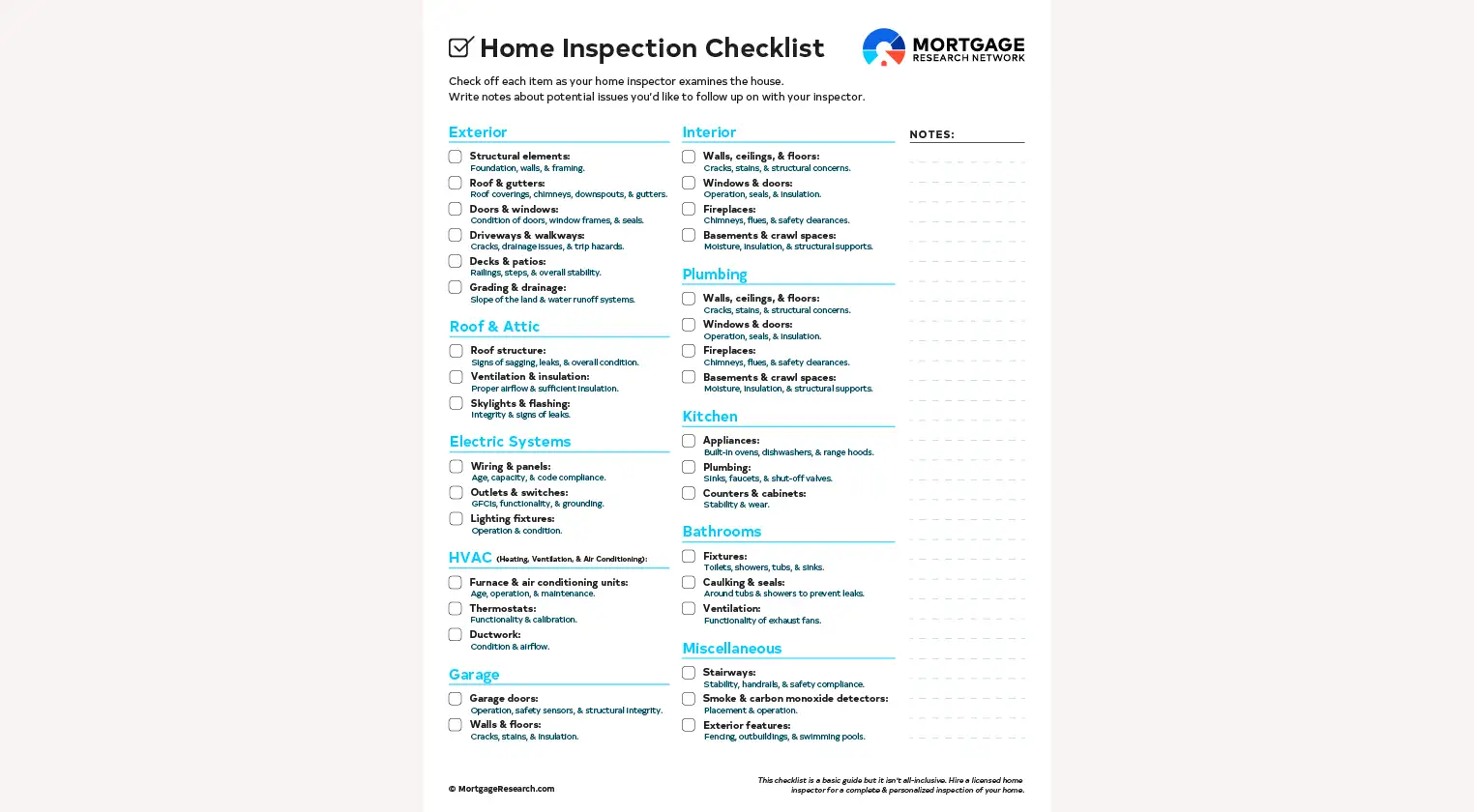Free Home Inspection Checklist PDF Download

A home inspection can save you thousands in the long run. Use this checklist as you walk the home with the licensed home inspector.
Buying a home is an exciting milestone, but there’s a level of risk involved.
One way to reduce that risk is a home inspection. In fact, it’s an essential step to help ensure your dream home doesn’t become a costly nightmare.
It’s more than just a formality—it’s a way to protect your investment, uncover hidden issues, and make informed decisions.
Free Home Inspection Checklist PDF Download
While you shouldn't use the checklist to perform an inspection yourself, it's a handy guide to refer to as you're walking the home with your licensed home inspector.
Click the image below, or simply click here, to download the free printable PDF. No personal information is required for the download. It's truly free.
Here's the text version of the checklist:
Exterior
Structural elements: Foundation, walls, and framing.
Roof and gutters: Roof coverings, chimneys, downspouts, and gutters.
Doors and windows: Condition of exterior doors, window frames, and seals.
Driveways and walkways: Cracks, drainage issues, and trip hazards.
Decks and patios: Railings, steps, and overall stability.
Grading and drainage: Slope of the land and water runoff systems.
Interior
- Walls, ceilings, and floors: Cracks, stains, and structural concerns.
- Windows and doors: Operation, seals, and insulation.
- Fireplaces: Chimneys, flues, and safety clearances.
- Basements and crawl spaces: Moisture, insulation, and structural supports.
Roof and Attic
Roof structure: Signs of sagging, leaks, and overall condition.
Ventilation and insulation: Proper airflow and sufficient insulation.
Skylights and flashing: Integrity and signs of leaks.
Plumbing
Water supply and drainage: Pipes, faucets, and water pressure.
Water heater: Capacity, safety features, and functionality.
Sewage system: Septic tanks or sewer connections.
Electrical Systems
Wiring and panels: Age, capacity, and code compliance.
Outlets and switches: GFCIs, functionality, and grounding.
Lighting fixtures: Operation and condition.
HVAC (Heating, Ventilation, and Air Conditioning)
Furnace and air conditioning units: Age, operation, and maintenance.
Thermostats: Functionality and calibration.
Ductwork: Condition and airflow.
Kitchen
Appliances: Built-in ovens, dishwashers, and range hoods.
Plumbing: Sinks, faucets, and shut-off valves.
Counters and cabinets: Stability and wear.
Bathrooms
Fixtures: Toilets, showers, tubs, and sinks.
Caulking and seals: Around tubs and showers to prevent leaks.
Ventilation: Functionality of exhaust fans.
Garage
Garage doors: Operation, safety sensors, and structural integrity.
Walls and floors: Cracks, stains, and insulation.
Miscellaneous
Stairways: Stability, handrails, and safety compliance.
Smoke and carbon monoxide detectors: Placement and operation.
Exterior features: Fencing, outbuildings, and swimming pools (if applicable).
What Is a Home Inspection?
A home inspection is a thorough evaluation of a property’s condition, conducted by a professional home inspector.
These experts examine key components of the home, from the foundation to the roof, identifying potential problems and safety concerns. Their findings are compiled into a detailed report, which provides homebuyers with a clear picture of the home’s physical condition.
Professional home inspectors bring invaluable expertise to the table, helping buyers spot issues that might not be visible during a casual walkthrough. They act as your guide, ensuring you’re fully informed about the overall shape of the home before making a commitment.
Why Is a Home Inspection Important?
In short, a home inspection protects you.
It can uncover hidden issues such as structural problems, plumbing leaks, or mold. Identifying these early can save you from unexpected expenses down the line.
Inspection findings can be used to renegotiate the purchase price or request that the seller make repairs before closing.
According to John Battaglia, Owner of At Ease Inspections in Canton, Ga., “A home inspection can end up being one of your best investments. We have had clients who paid $500 for an inspection and were able to use the inspection report to get $50,000 in concessions from the seller. That’s a 9,900% return in just a matter of days!”
Additionally, knowing that your potential home has been thoroughly inspected provides confidence that you’re making a sound investment.
A home inspection can highlight potential hazards, like outdated wiring or code violations, ensuring the property is safe for you and your family.
Common Issues Found During Inspections
Home inspections often reveal issues that require attention. Some of the most common include:
Structural Concerns: Cracks in the foundation, sagging roofs, or uneven floors.
Electrical Problems: Outdated wiring, overloaded panels, or non-functioning outlets.
Plumbing Issues: Leaks, low water pressure, or faulty water heaters.
HVAC System Problems: Inefficient heating and cooling units or ductwork issues.
Mold, Pests, or Water Damage: Signs of moisture intrusion or pest infestations.
How Much Does a Home Inspection Cost?
The cost of a home inspection varies depending on the property’s size, location, and complexity. Generally, buyers can expect to pay between $300 and $500. Unlike many other closing costs, you generally pay the home inspector at the time of the service.
While this may seem like an added expense, it’s a small price to pay for peace of mind and protection.
Check out our guide to home inspection costs here.
The Home Inspection Process
A thorough home inspection will typically take several hours, during which the inspector carefully examines the property.
As they move through the home, they’ll take notes, capture photos, and, if you’re present, provide insights on what they observe. Most importantly, they offer an unbiased assessment of the home’s condition, free from the emotional attachment that often comes with the homebuying process.
While some inspectors may point out child-safety concerns, this depends on their experience and expertise. However, their primary role is not to verify whether the home complies with local building codes.
They also won’t focus on cosmetic issues unless those issues indicate a more serious problem. For example, they might highlight a stain on the ceiling as a potential sign of water damage.
Despite their attention to detail, inspectors can’t uncover everything. Issues such as hidden pests, asbestos, mold, or other hazardous materials may go undetected.
Additionally, areas that aren’t easily accessible—such as a septic system—typically require specialized inspections beyond a standard home evaluation.
What Happens After the Inspection?
After the home inspection, you’ll receive a copy of the report. You should carefully examine the detailed findings.
A reliable inspector will review their findings with you, including even minor wear and tear. Since their job is to document every flaw, the report may contain a long list of issues, but not all will be cause for concern.
The inspector can help distinguish between minor imperfections and serious hazards.
Next, you’ll need to decide which repairs are essential and whether to negotiate with the seller, and determine whether to move forward with the purchase or reconsider based on the inspection results.
What If Issues Are Found?
Most home inspection reports will list dozens of defects. Don’t panic. Many of these items could be minor and more of an “FYI”.
Rather than focusing on the number of issues in the inspector’s report, prioritize the significance of the problems.
Some issues, like a loose fixture or small cracks in the driveway, are minor and unlikely to require immediate attention, even if you’re aware of them.
However, more serious problems could be potential deal-breakers—such as structural damage, safety hazards like lead piping, or improperly installed water heaters.
Request Financial Concessions
Inspection findings can lead to price reductions, seller concessions, or repair agreements. If significant concerns arise, consult with your home inspector and real estate agent to determine the best course of action moving forward.
For example, the inspector finds water intrusion in the attic, indicating a bad roof estimated to be a $10,000 repair. With the help of your real estate agent, you request that the seller fix the problem or issue a $10,000 price reduction or closing cost credit.
Exit the Deal
A major issue can help you use your home inspection contingency to back out of the deal. Without that contingency, you may lose your earnest money by canceling the contract. As we discuss below, it’s rarely a good idea to waive the inspection contingency.
Budget
If the seller won’t budge, but you still want the house, a home inspection helps you budget for future fixes. Be proactive after the sale to address issues before they get worse — and budget accordingly.
How to Choose a Qualified Home Inspector
As the buyer, it’s your responsibility to hire a home inspector. Even if the seller provides a pre-inspection report or insists the home has already been evaluated, it’s best to arrange your own inspection to ensure you trust the inspector’s qualifications and findings.
Since home inspectors are not federally regulated and some states don’t require licensing, choosing the right professional is essential.
Start by asking friends, colleagues, or your real estate agent for recommendations. You can also search reputable industry organizations like the International Association of Certified Home Inspectors (InterNACHI) or the American Society of Home Inspectors (ASHI) , which require members to pass exams, follow ethical standards, and complete ongoing education.
You can also check the Better Business Bureau (BBB) or other review sites like Yelp for any complaints against an inspector to help you avoid potential issues.
Before hiring an inspector, look into their training, experience, and areas of expertise.
If you’re buying an older home or a fixer-upper, look for someone with a background in historic properties. Request references from past clients—especially those who have lived in their homes for at least six months—to see if any major issues arose that weren’t covered in their inspection.
Additionally, ask to see sample reports. Pay attention to whether they are basic checklists or thorough, detailed assessments with photos. This will help you understand the level of insight you’ll receive and ensure you’re getting the most value from the inspection.
Should You Ever Skip a Home Inspection or Waive the Inspection Contingency?
Some buyers waive inspections or the inspection contingency to make their offer more appealing. An inspection contingency is a clause in the purchase contract that says you can exit the deal without penalty if the inspection reveals issues.
Always leave yourself a way out in case the home is hiding some costly secrets such as hidden structural damage or outdated systems.
Issues like poor electrical wiring or plumbing can quickly result in expensive repairs. By investing in a home inspection, you can avoid these potential pitfalls, ensuring your new home is both safe and sound.
What about New Construction?
Many people assume that newly constructed homes are flawless simply because they are brand new. However, this is not always the case.
In fact, according to Battaglia, this is rarely the case.

There is a common belief that the county inspectors will catch anything wrong while a house is being built, but that is simply not true. Municipal inspectors will inspect specific items at specific times but will not perform a comprehensive inspection of the entire home. After doing thousands of inspections on new construction homes, we have never had one where we did not find multiple code violations that needed to be corrected
Conclusion: Don’t Skip Your Home Inspection
A home inspection is an indispensable part of the home-buying process. It protects your investment, provides peace of mind, and ensures you’re making an informed decision.
By hiring a qualified inspector and following a thorough checklist, you can confidently move forward in your home buying journey.
Take the time to prioritize this critical step—your future self will thank you.







